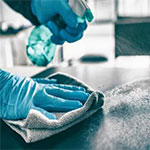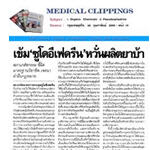
|
รองศาสตราจารย์ ดร.ภญ. อ้อมบุญ วัลลิสุต ภาควิชาเภสัชวินิจฉัย คณะเภสัชศาสตร์ มหาวิทยาลัยมหิดล |
|
| 76,859 ครั้ง เมื่อ 7 ช.ม.ที่แล้ว | |
| 2016-10-05 |
ปัจจุบันโรคตาที่เป็นปัญหากันมาก เช่น ต้อกระจก ต้อหิน จอประสาทตาเสื่อม (AMD) และวุ้นตาเสื่อม ซึ่งสาเหตุหนึ่งมาจากความเสื่อมของดวงตาที่เกิดจากอนุมูลอิสระ ดังนั้นจึงมีการนำเอาสมุนไพรและสารจากธรรมชาติซึ่งมีฤทธิ์ต้านออกซิเดชันมาใช้ประโยชน์อย่างกว้างขวาง ตัวอย่างสมุนไพรและสารจากธรรมชาติ ได้แก่ 
ขมิ้น พืชที่มีชื่อวิทยาศาสตร์ว่า Curcuma longa ใช้เป็นส่วนประกอบของอาหารในเอเชียและใช้เป็นยารักษาโรคที่เกี่ยวข้องกับอาการอักเสบมาช้านาน มีสารสำคัญ คือ curcumin (1) ซึ่งมีผลต่อยับยั้งการทำงานของเอนไซม์ที่เกี่ยวข้องกับการอักเสบ ได้แก่ cyclooxygenase-2 (COX-2), lipoxygenase, nitric oxide synthase (iNOS) และยับยั้งการผลิตไซโตไคน์ที่ทำให้เกิดการอักเสบหลายชนิด ได้แก่ TNF-alpha, interleukins, monocyte chemoattractant protein (MCP), Migration inhibitory protein นอกจากนี้ เมื่อทำการทดลองสาร curcumin (2,3) มีในสัตว์ทดลองและ retina cell culture พบว่า สามารถปกป้อง retina จากแสงได้เมื่อให้หนูทดลองกินอาหารที่มี 0.2% curcumin เป็นเวลา 2 อาทิตย์ (4) และ curcumin ในความเข้มข้น 15 ?M สามารถป้องกัน human retinal cell จากผลของน้ำ (H2O2) โดยการลดระดับของ reactive oxygen species (ROS) (5) ยังมีการทดลองอีกหลายรายงานในหนูที่แสดงว่า curcumin สามารถป้องกันภาวะเบาหวานขึ้นจอตา (diabetic retinopathy หรือ DR) (6) และ ต้อกระจก (7)
Saffron เป็นเครื่องเทศและใช้ในยาแผนโบราณเป็นสารต้านพิษ (antitoxic) มีสารสำคัญคือ crocin และ crocetin มีฤทธิ์เป็น antioxidant และปกป้องเซลล์จาก ROS (8,9) การทดลองในหนูพบว่า saffron เพิ่มระดับ glutathione จึงสามารถลดผลเสียจากการที่หนูได้รับแสงจ้าเป็นเวลานานและสามารถป้องกันการตายของเซลล์ได้ (10) และยังสามารถป้องกัน selenite-induced cataract ในหนูทดลองได้อีกด้วย (11) การทดลองทางคลินิกในคนที่เริ่มเป็น จอประสาทตาเสื่อม ด้วยการให้ saffron วันละ 20 มก เป็นเวลา 90 วัน พบว่าจุดภาพชัด (macula) ในตา สามารถทำหน้าที่ได้ดีขึ้น (12)
Ginseng หรือโสม คือรากของ Panax ginseng นิยมใช้ในแพทย์แผนจีน สารสำคัญคือ ginsennosides ซึ่งเป็น steroidal saponin มีฤทธิ์ทางเภสัชวิทยาหลายชนิด ได้แก่ antiapoptotic, anti-inflammatory, antioxidant (13) จากการทดลองทางคลินิกในผู้ป่วยที่เป็นต้อหิน พบว่า โสมแดงเกาหลีสามารถเพิ่มการไหลเวียนของเลือดไปยังจอตา จึงน่าจะเป็นประโยชน์ในลักษณะการป้องกันโรคต้อหิน (14) นอกจากนี้สาร Rb1 และ Rg3 ยังมีฤทธิ์ยับยั้ง TNF-alpha จึงน่าจะเป็นประโยชน์ในการป้องกันโรคจอประสาทตาเสื่อมด้วย เนื่องจากการอักเสบเป็นสาเหตุหนึ่งของโรคนี้ (15) การทดลองในหนูแสดงว่าโสมสามารถลดการเสื่อมของจอตาในหนูที่ถูกเหนี่ยวนำให้เป็นเบาหวานได้ (16) ลดผลที่เกิดจากการเหนี่ยวนำหนูให้เป็นต้อกระจกด้วย selenite ได้ (17) ดังนั้นโสมจึงเป็นสมุนไพรที่น่าสนใจสำหรับการป้องกันโรคตาทั้ง 4 คือ โรคต้อหิน ต้อกระจก จอประสาทตาเสื่อม และภาวะเบาหวานขึ้นจอตา
Gingko Biloba Extract (GBE) คือสารสกัดจากใบของต้นแป๊ะก๊วย (Ginkgo biloba) ในใบมีสารสำคัญสองกลุ่มคือ เฟลโวนอยด์และเทอร์พีนอยด์ GBE เป็นอาหารเสริมที่นิยมมากที่สุดในยุโรปและอเมริกามีฤทธิ์ป้องกันการทำลายจากอนุมูลอิสระ และป้องกัน lipid peroxidation จากการทดลองพบว่า GBE สามารถป้องกันการเสื่อมของ mitochondria (18-19) ป้องกันการเสื่อมของ optic nerve จึงสามารถป้องกันตาบอดในผู้ป่วยโรคต้อหิน และ ผู้ป่วยจอตาเสื่อมได้ (20) มีการทดลองในหนูโดยให้ GBE ฉีดเข้าท้องก่อนทำลาย optic nerve พบว่าหนูที่ได้รับ GBE มีเซลล์ประสาทของจอตามากกว่ากลุ่มควบคุมอย่างมีนัยสำคัญ (21) สาร EGB761 จากสารสกัดใบแป๊ะก๊วยยับยั้งการตายของเซลล์รับแสง (photoreceptor cell) และเพิ่มอัตราการอยู่รอดของเซลล์ภายหลังถูกฉายด้วยแสงจ้า (22) และสามารถลดการหลุดของจอตา (retinal detachment) ได้ (20) GBE จึงมีประโยชน์ในกรณีป้องกันและรักษาโรคต้อหิน และโรคที่เกี่ยวข้องกับจอตา (23)
Danshen ชื่อสามัญคือ Asian Red Sage หรือตังเซียม หรือตานเซิน (Salvia miltiorrhiza) ส่วนที่ใช้คือราก ในตำรายาใช้เป็นยากระตุ้นการไหลเวียนเลือด ใช้รักษาฝี สารสำคัญคือ salvianoic acid B เป็นสารพอลีฟีนอลิกละลายน้ำและเป็น antioxidant ที่มีฤทธิ์แรงและยังมีฤทธิ์ต้านการอักเสบ(24) ในคนที่เป็นเบาหวานจะเกิดอาการอักเสบและหนาขึ้นของผนังเส้นเลือดฝอยทำให้ อนุมูลอิสระไม่สามารถถูกกำจัดออกไปได้จึงไปทำลายเซลล์ประสาทตา เมื่อทดลองฉีดตังเซียมเข้าไปที่เนื้อเยื่อจอตาที่ขาดออกซิเจนในหนูที่เป็นเบาหวานพบว่าสามารถป้องกันการสูญเสียการมองเห็นได้ (25) การทดลองทางคลินิกในผู้ป่วยโรคต้อหินพบว่า ตังเซียมสามารถคงสภาพลานสายตา (visual field) ในผู้ป่วยระยะกลางและระยะปลายได้ (26) ดังนั้น ตังเซียมจึงมีประโยชน์กับผู้ป่วยโรคตาที่เกี่ยวข้องกับ oxidative stress เช่น จอประสาทตาเสื่อม ภาวะเบาหวานขึ้นจอตา และต้อกระจก
Quercetin เป็นเฟลโวนอยด์ในพืชที่มีการศึกษามาก พบได้ในชาดำและชาเขียว พืชในวงศ์ผักกาด (Brassica spp.) ผลไม้หลายชนิด เนื่องจากพบว่าการบริโภคอาหารที่มีสารเฟลโวนอยด์ช่วยลดอัตราการป่วยด้วยโรคหลอดเลือดและหัวใจได้ (27,28) และมีการศึกษาฤทธิ์ต้านอักเสบและต้านออกซิไดส์กันอย่างกว้างขวาง (29) ในการทดสอบกับ retinal cell line พบว่า quercetin สามารถยับยั้งการอักเสบและป้องกันการตายของเซลล์ได้ (30) ยับยั้งการเกิดเส้นเลือดใหม่ของจอตา (retinal angiogenesis) (31,32) ซึ่งเป็นลักษณะเฉพาะของโรคจอประสาทตาเสื่อม
Resveratrol สารพอลิฟีนอลที่พบมากในเหล้าองุ่นแดงซึ่งได้รับความสนใจจากการที่คนฝรั่งเศสนิยมดื่มเหล้าองุ่นแดงกันมาก แต่กลับเป็นโรคหลอดเลือดหัวใจกันน้อยกว่าประเทศอื่นๆ จึงทำให้มีการศึกษาผลของสารนี้ต่อเส้นเลือด และพบว่ามีฤทธิ์ต้านออกซิเดชัน สามารถยับยั้งการเกาะตัวของเกร็ดเลือด ยับยั้งสารก่อการอักเสบ ยับยั้งการสร้าง endothelin ที่ทำให้หลอดเลือดหดตัว (33) การทดลองในหนูยังพบว่า resveratrol ลดการทำลายของหลอดเลือดในหนูที่เป็นเบาหวานได้ (34,35) จึงน่าจะเป็นประโยชน์กับผู้ป่วยเบาหวานจากการป้องกันการตายของเซลล์ และในโรคต้อหิน ซึ่งเกิดจากการขาดเลือดของจอตา (36,37) resveratrol ยังสามารถป้องกันโรคต้อกระจกในหนูที่ถูกเหนี่ยวนำด้วย selenite โดยเพิ่มระดับ glutathione และลดระดับ malonyl dialdehyde ในเลนส์ตา (38) ดังนั้น resveratrol จึงเหมาะที่จะใช้ในการป้องกันโรคจอประสาทตาเสื่อม ภาวะเบาหวานขึ้นจอตา ต้อหิน ต้อกระจก ชึ่งล้วนเกิดจาก oxidative stress
Catechins กลุ่มสารพอลิฟีนอลิคที่พบมาในชาเขียว ซึ่งอนุพันธุ์ที่มีมากสุดคือ epigallocatechin gallate (EGCG) เป็นสารต้านออกซิไดส์ที่มีฤทธิ์แรงมาก (39) เมื่อฉีดเข้าไปในลูกตาพร้อมกับ Sodium Nitroprusside สามารถป้องกันเซลล์รับแสงของจอตาได้ (40) กลไกการออกฤทธิ์ของ catechin คือกำจัดอนุมูลอิสระ (oxygen free radicals) และลดการออกซิไดส์ไลปิด (41) เมื่อให้ EGCG ทางปากแก่หนูทดลองสามารถลดการตายของเซลล์รับภาพของจอตาจากการเหนี่ยวนำด้วยแสงได้ แสดงว่า EGCG สามารถใช้ป้องกันการเสื่อมของเซลล์รับภาพได้ (42) catechin ที่ให้ทางปากแก่หนู สามารถยับยั้งการเสื่อมของ lens epithelium ในหนูที่ถูกเหนี่ยวนำให้เป็นโรคต้อกระจกได้ (43) และ EGCG มีฤทธิ์ยับยั้ง RPE migration and adhesion จึงสามารถป้องกันจอประสาทตาเสื่อมได้ (44) ดังนั้น catechin จึงมีศักยภาพในการป้องกันจอประสาทตาเสื่อมและต้อกระจกได้
นอกจากนี้ยังมีกรดไขมันจำเป็น วิตามิน และแร่ธาตุที่จำเป็น
สารกลุ่มกรดไขมันจำเป็นชนิดโอเมกา-3 เช่น กรดอัลฟาลิโนเลนิค (Alpha- Linolenic acid, ALA) มีในน้ำมันเมล็ดแฟล็กซ์ ( Flaxseed oil หรือ Linseed oil) มีการทดลองทางคลินิกโดยให้โอเมกา-3 วันละ 3 ครั้งๆ ละ 2 x 1000 มก และติดตามผลทุก 3 เดือนเป็นเวลา 1 ปี พบว่าสามารถลดอาการตาแห้ง ช่วยทำให้คุณภาพของน้ำตาดีขึ้น และบำรุงประสาทตา (45)
วิตามินและเกลือแร่ ที่สำคัญคือ วิตามินเอ (Vitamin A) วิตามินบี 2 (Riboflavin) วิตามินซี และสังกะสี (Zinc) วิตามินเอเป็นสารจำเป็นในการสังเคราะห์ Rhodopsin ซึ่งเป็นเม็ดสีที่อยู่ในเซลล์ประสาทรับภาพชนิด Rod ซึ่งทำหน้าที่การเห็นภาพในที่สลัวหรือในเวลากลางคืน การขาดวิตามินเอจึงทำให้ตาบอดกลางคืน (Night Blindness) (46) วิตามินบี 2 (Riboflavin) ช่วยในการบำรุงสายตา เยื่อเมือกตาและม่านตา ถ้าขาด จะมีอาการเลือดออกในตา ตาไวต่อแสง อาการแสบตา (47) วิตามินซีเป็น antioxidant ที่ละลายน้ำได้และช่วยให้ผนังหลอดเลือดฝอยแข็งแรง American Optometric Association สรุปว่าวิตามินซีป้องกันต้อกระจกและจอประสาทตาเสื่อมได้ สังกะสีเป็นแร่ธาตุที่เกี่ยวข้องในการสร้างเม็ดสีเมลานินที่จอตา ถ้าขาดจะทำให้การมองเห็นในที่มืดไม่ดีและเป็นต้อกระจก (48)
แหล่งอ้างอิง/ที่มา
- Tilak IC, Banerjee M, Mohan H, and Devasagayam TPA, Antioxidant availability of turmeric in relation to its medicinal and culinary uses, Phytotherapy Research, 2004;18(10): 798-804.
- Goel A, Kunnumakkara AB, and Aggarwal BB, Curcumin as "Curecumin": from kitchen to clinic, Biochemical Pharma?cology, 2008;75(4):787-809.
- Abe Y, Hashimoto S, and Horie T, Curcumin inhibition of inflammatory cytokine production by human peripheral blood monocytes and alveolar macrophages, Pharmacological Research, 1999; 39(1): 41-47.
- Mandal MNA, Patlolla JMR, Zheng L et al, Curcumin protects retinal cells from light-and oxidant stress-induced cell death, Free Radical Biology and Medicine, 2009; 46( 5):672- 679.
- Woo JM, Shin DY, Lee SJ et al,Curcumin protects retinal pigment epithelial cells against oxidative stress via induction of heme oxygenase-I expression and reduction of reactive oxygen, Molecular Vision, 2012; 18:901-908.
- Gupta SK, Kumar B, Nag Tc et al, Curcumin prevents experimental diabetic retinopathy in rats through its hypoglycemic, antioxidant, and anti-inflammatory mechanisms, Journal of Ocular Pharmacology and Therapeutics,2011; 27(2): 123-130.
- Raju TN, Kumar CS, Kanth VR et al, Cumulative antioxidant defense against oxidative challenge in galactose-induced cataractogenesis in Wistar rats, Indian Journal of Experimantal Biology, 2006; 44(9): 733-739.
- Giaccio M, Crocetin from saffron: an active component of an ancient spice, Critical Reviews in Food Sciences and nutrition, 2004;44(3):155-172.
- Soeda S, Ochiai T, Paopong L, Tanaka H, Shoyama Y and Shimeno H, Crocin suppress tumour necrosis factor-alpha-induced cell death of neuronally differentiated PC-12 cells, Life Sciences, 2001;69(24):2887-2898.
- Maccarone R, Di Marco S, and Bisti S, Saffron supplement maintains morphology and function after exposure to damag?ing light in mammalian retina, Investigative Opthalmiology and Visual Science, 2008;49(3):1254-1261.
- Makri OE, Ferlemi A, Lamari FN, and Georgakopoulos CD, Effect of Crocus sativus stigmas (saffron) extract on sodium selenite induced cataract formation, Acta Ophthalmologica, 2012;90: article s249.
- Falsini B, Piccardi M, Minnella A et al, Influence of saffron supplementation on retinal flicker sensitivity in early age-related macular degeneration, Investigative Ophthalmology and Visual Science, 2010;51(12): 6118-6124.
- Attele AS, Wu JA, and Yuan C, Ginseng Pharmacology: multiple constituents and multiple actions, Biochemical Pharmacology, 1999;58(11):1685-1693.
- Kim NR, KimJH, and Kim CY, Effect of Korean red ginseng supplementation on ocular blood flow in patients with glaucoma, Journal of Ginseng Research, 2010;34(3);237- 245.
- Cho JY, Yoo ES, Baik KU, Park MH, and Han BH, In vitro inhibitory effect of protopanaxadiol ginsenosides on tumor necrosis factor (TNF)-alpha production and its modulation by known TNF-a antagonists, Planta Medica, 2001;67(3):213-218.
- Sen S, Chen S, Wu Y, Feng B, Lui EK, and Chakrabarti S, Preventive effects of North American ginseng (Panax quinquefolius) on diabetic retinopathy and cardiomyopathy, Phytotherapy Research, 2012;27(2):290-298.
- Lee SM, Sun JM, Jeong JH et al, Analysis of the effective fraction of sun ginseng extract in selenite induced cataract rat model, Journal of the Korean Ophthalmological Society, 2010;51:733-739.
- Janssens D, Delaive E, Remacle J, and Michiels C, Protection by bilobalide of the ischaemia-induced alterations of the mitochondrial respiratory activity, Fundamental and Clinical Pharmacology, 2000;14(3):193-201.
- Sastre J, Lloret A, Borris C et al, Ginkgo biloba extract EGb 761 protects against mitochondrial aging in the brain and in the liver, Cell and Molecular Biology, 2002;48(6):685-692.
- Maclennan KM, Darlington CL, and Smith PF, The CNS effects of Ginkgo biloba extracts and ginkgolide B, Progress in Neurobiology, 2002;67(3):235-257
- Ma K, Xu L, Zhang H, Zhang S, Pu M, and Jonas JB, The effect of ginkgo biloba on the rat retinal ganglion cell survival in the optic nerve crush model, Acta Opthalmologica, 2010;88(5):553-557.
- Qiu QH, Xie ZG, Xu X, Liang SX, and Gao Y, EGB761 on retinal light injury in rats, Chinese Medical Journal, 2012;125(13):2306-2309
- Cybulska-Heinrich AK, Mozaffarieh M, and Flammer J, Ginkgo biloba: an adjuvant therapy for progressive normal and high tension glaucoma, Molecular Vision, 2012;18:390-402.
- Chen Y, Lin S, Ku H et al, Salvianolic acid B attenuates VCAM-1 and ICAM-1 expression in TNF-alpha-treated human aortic endothelial cells, Journal of Cellular Biochemistry,2001;82(3):512-521.
- Zhang L, Dai SZ, Nie XD, Zhu L, Xing F, and Wang LY, Effect of Salvia miltiorrhiza on retinopathy, Asian Pacific Journal of Tropical Medicine, 2013;6(2):145-149.
- Wu ZZ, Jiang JY, Yi YM, and Xia MT, Radix Salvia miltiorrhizae in middle and late stage glaucoma, Chinese Medical Journal, 1983;96(6):445-447.
- Bhagwat S, Haytowitz DB, and Holden JM, USDA Database for the Flavonoid Content of Selected Foods, United States Department of Agriculture, 2011.
- Formica JV and Regelson W, Review of the biology of quercetin and related bioflavonoids, Food and Chemical Tox?icology,1995;33(12):1061-1080.
- Stewart LK, Soileau JL, Ribnicky D et al, Quercetin tran?siently increases energy expenditure but persistently decreases circulating markers of inflammation in C57BL/6J mice fed a high-fat diet, Metabolism, 2008;57(1):S39-S46.
- Cao X, Liu M, Tuo J, Shen D, and Chan C, The effects of quercetin in cultured human RPE cells under oxidative stress and in Ccl2/Cx3crl double deficient mice, Experimental Eye Research, 2010;91(1):15-25.
- Chen Y, Li X, Xing N, and Cao X, Quercetin inhibits choroidal and retinal angiogenesis in vitro, Graefe’s Archive for Clinical and Experimental Ophthalmology, 2008;246(3):373-378.
- Zhuang R, Shen Y, Lin BQ, Zhang WY, and Chiou GC, Effect of quercetin on formation of choroidal neovasculariza?tion (CNV) in age-related macular degeneration (AMD), Eye Science, 2011;26(1):23-29.
- Corder R, Douthwaite JA, Lees DM et al, Endothelin-1 synthesis red wine, Nature, 2001;414(6866):863-864.
- Kim YH, Kim YS, Roh GS, Choi WS, and Cho GJ, Resveratrol blocks diabetic-induced early vascular lesions and vascular endothelial growth factor induction in mouse retinas, Acta Ophthalmologica, 2012;90(1): e31-e37.
- Hua J, Guerin KI, Chen J et al, Resveratrol inhibit pathologic retinal neovascularization in Vldlr-/- mice, Investigative Ophthalmology and Visual Science, 2011;52(5):2809-2816.
- Kwok TL, Chiou RYY, Li GC et aL, Neuroprotective effects of resveratrol on cerebral ischemia-induced neuron loss mediated by free radical scavenging and cerebral blood flow elevation, Journal of Agricultural and Food Chemistry, 2006;54(8):3126-3131.
- Osborne NN, Casson RJ, Wood JPM, Chidlow G, Graham M, and Melena J, Retinal ischemia: mechanisms of damage and potential therapeutic strategies, Progress in Retinal and Eye Research, 2004;23(1):91-147.
- Doganay S,Borazan M,Iraz M, and Cigremis Y, The effect of resveratrol in experimental cataract model formed by sodium selenite, Current Eye Research, 2006;31(2):147-153.
- Lee S, Im K, Suh S, and Jung J, Protective effect of green tea polyphenol (-)-epigallocatechin gallate and other antioxidants on lipid peroxidation in gerbil brain homogenates, Phytotherapy Research, 2003;17(3): 206-209.
- Zhang B and Osborne NN, "Oxidative-induced retinal degeneration is attenuated by epigallocatechin gallate, Brain Research, vol. 1124, no. 1, pp. 176-187, 2006.
- Siu AW, Lau MK, Cheng JS et al, Glutamate-induced retinal lipid and protein damage: the protective effects of catechin, Neuroscience Letters,2008;432(3):193-197.
- Costa BLDSAD, Fawcett R, Li G, Safa R, and Osborne NN, Orally administered epigallocatechin gallate atten?uates light-induced photoreceptor damage, Brain Research Bulletin, 2008;76(4):412-423.
- Lee SM, Ko I, Kim S, Kim DH, and Kang BN, Protective effect of catechin on apoptosis of the lens epithelium in rats with N-methyl-N-nitrosourea-induced cataracts, Korean Journal of Ophthalmology, 2010; 24(2):101-107.
- Chan C, Huang J, Chiang H et al, Effects of (-)- epigallocatechin gallate on rpe cell migration and adhesion, Molecular Vision, 2010;16:586-595.
- Macsai MS,The Role of Omega-3 Dietary Supplementation in Blepharitis and Meibomian Gland Dysfunction (An AOS Thesis) Trans Am Ophthalmol Soc. 2008 Dec; 106: 336–356. PMCID: PMC2646454
- Busti AJ, The Mechanism for Vitamin A Improvements in Night Vision. From: http://www.ebmconsult.com/articles/vitamin-a-eye-vision-mechanism
- เริงฤทธิ์ สัปปะพันธุ์ บรรณาธิการ คู่มืออาหารเสริม กรุงเทพฯ เอ็มไอเอส ISBN 978-616-527-392-3, 2556:เบตาแคโรทีน 315-318, วิตามินบี 2;71-72
- Age-Related Eye Disease Study Research Group, A randomized, placebo-controlled, clinical trial of high-dose supplementation with vitamins C and E, beta carotene, and zinc for age-related macular degeneration and vision loss: AREDS report no. 8. Arch Ophthalmol. 2001;119(10):1417-1436.
บทความที่ถูกอ่านล่าสุด

|
ยาคุมกำเนิดชนิดฉีด 38 วินาทีที่แล้ว |

|
ลูกดูดนมยาก - ภาวะลิ้นติดในทารก 48 วินาทีที่แล้ว |

|
กระท่อม .. พืชที่ทุกคนอยากรู้ 1 นาทีที่แล้ว |

|
ไข้ซิกา …ภัยใหม่จากยุงลายตัวเก่า 1 นาทีที่แล้ว |

|
ต้อกระจก 1 นาทีที่แล้ว |

|
ยาหอม กับคนวัยทำงาน 1 นาทีที่แล้ว |

|
ท้องผูกและการใช้ยาระบาย 1 นาทีที่แล้ว |

|
การเลือกซื้อผลิตภัณฑ์ทำความสะอาด 1 นาทีที่แล้ว |

|
ซูโดเอฟีดรีน (pseudoephedrine) พระเอกหรือผู้ร้าย? 2 นาทีที่แล้ว |

|
ยาเขียว ยาไทยใช้ได้ทั้งผู้ใหญ่และเด็ก… 2 นาทีที่แล้ว |
